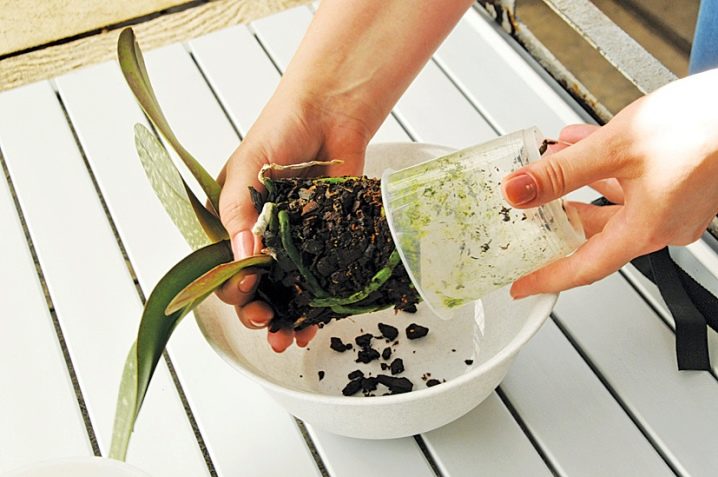Nuances of growing Dracula orchids at home
In order for an orchid with a monkey's face to grow in an apartment or a private house, without causing trouble for the grower, the plant should organize an appropriate microclimate: maintain the desired level of temperature, illumination and humidity in the room. This is a rather laborious process, due to which the exotic flower is rarely cultivated by amateurs.
Temperature regime
The orchid does not tolerate heat well. In summer, the temperature in the containment room should not exceed 25 ° C, otherwise the flower will begin to wither. In winter, the critical minimum is 12 ° C. To stimulate flowering, the plant should be provided with daily drops, when the difference between day and night temperatures is 4 ° C.
Illumination

In the wild, monkey-faced orchids grow in the lower tier of the jungle and do not respond well to direct sunlight. To make the flower feel comfortable at home, it should be placed on the windowsills of the western and eastern windows. In their absence, it is permissible to install a pot near the southern windows, but you need to take care of the curtains in advance. At noon, they should be tugged.
Humidity
An important indicator, which is not easy to provide under artificial conditions. In the jungle, the orchid grows in conditions of systematic rain and fog, typical for tropical climates. However, the air moves all the time, which is difficult to repeat at home. It is necessary to carry out daily spraying from a fine-dispersed spray gun or install a stationary humidifier, at the same time a fan must work to improve aeration.
For information! If it is not possible to install a humidifier, you can do with handy means: place a container of water next to the orchid.
Home care for the Dracula orchid
Compliance with cultivation agrotechnology is the basis for the successful cultivation of any crop. If it is a tropical plant, all requirements should be strictly adhered to, otherwise it will die. It is necessary to organize a system of watering, feeding and replant it in a timely manner.
How to water
Moistening is carried out only after the substrate has dried. But they do it right away, because the roots are very sensitive. It is best to immerse the pot in a container of water and wait about 20-30 minutes for the plant to drink.
An important rule is that the cooler it is in the room, the less often watering is needed.
Substrate
Since the flower has an epiphytic form of development, the roots need air access. It can be grown both in a basket, on a log, and in a substrate based on bark. In addition, you should add moss, which retains moisture, wood ash, which prevents the rapid decomposition of the main component of the soil mixture. Acidity is neutral.
Top dressing
To grow a flower in artificial conditions, you should organize additional nutrition for it in the form of special fertilizers for orchids. Prepare a working solution with a concentration 2 times less than indicated on the package. The plant is fed only during the active growing season, gradually reducing the frequency.
Transfer
The flower is transplanted in the spring with strong growth. A slightly larger container is selected and filled with an appropriate bark and moss substrate. Before filling the roots of the flower, placed in a container on the drainage layer, they must be straightened. It is impossible to tamp the soil mixture, so as not to impair aeration.
Looseness is an important requirement for successful crop cultivation
For information! The flower does not have a pronounced dormant period, it can bloom at any time of the year.The stage of stagnation is organized only when it is not possible to provide the required level of lighting.
Protection against diseases and pests

The plant has good immunity. Most often, it is affected by fungal diseases with improper care - an excess of moisture. If there are signs of the disease in the form of stem softness, yellowing of the leaves, the culture should be sprayed with a fungicide solution and transplanted into a fresh substrate. From pests with too dry air, orchid shoots can attack aphids, spider mites, thrips. An effective method of protection is treatment with an insecticide working solution according to the manufacturer's instructions.
How to take care at home?
Seat selection
The flower grows well in the east or southeast in the presence of diffused light. If you place it in the north, then artificial lighting will be needed in winter.
Preparing the soil and pot
Transparent plastic pots or wicker baskets are suitable for Dracula. Sphagnum moss is covered at the bottom, then a substrate, which consists of:
- chopped fern roots;
- pine bark;
- charcoal.
The top layer usually contains moss, which retains moisture.
Temperature
In extreme heat, the plant can wither and shed its buds. In summer, the temperature should be maintained up to 24 degrees Celsius, in cold weather - at least 12 degrees above zero. The maximum difference between temperatures during the day and at night is 5 degrees. In this case, the flower buds will be well formed.
Humidity
Dracula needs high humidity, about 70-90%. To save the plant from fungi and bacteria, it is necessary to ventilate the room. It is not forbidden to use humidifiers or place a flower near a pallet with wet expanded clay. When heated, expanded clay will evaporate water and increase humidity.
Lighting
The flower likes to be in the shade or partial shade. An overabundance of light can destroy a flower, since in nature it grows under the dense foliage of trees. The windows where the plant is located should be north, north-west or north-east. It is recommended to use artificial light sources, for example phytolamps.
Watering
The plant should be watered regularly. Experts recommend using soft, melted or filtered water. The abundance and frequency of watering is determined by the room temperature and the amount of light. The soil must be sufficiently moist. To avoid root decay, it is necessary to monitor the excessive moisture of the substrate. Excessively dry soil can lead to the death of roots.
The most suitable way to water the plant is to put the flowerpot in the water for 20-30 minutes so that the water completely floods the soil.
Top dressing
The orchid is fed during active growth. Fertilize the plant with a special agent intended for a flower.
At every third watering, fertilizing is added in a proportion of half the amount specified by the fertilizer manufacturer.
Transfer
The monkey orchid does not require frequent replanting. With proper care, it is transplanted in the spring after active growth of greenery or before flowering.
Also, the plant must be transplanted when compaction, salinization of the soil or with a strong growth of roots. In this case, the flower is divided into several parts, each with four to five developed processes.
We offer you to watch a video on how to properly transplant the Dracula orchid:
Types of dendrobium with photos and names
There are many different types and varieties of dendrobium orchids, so it is very difficult to single out the best or most beautiful ones. Below will be described those species and varieties that are most popular with flower growers.
Dendrobium nobile (Dendrobium nobile)
This species is one of the most beautiful, it comes from Vietnam and the Himalayas.The length of the shiny thick pseudobulbs is about half a meter, in the second year of growth they form peduncles, on which 1-3 large (about 10 centimeters in diameter) flowers of a saturated color are formed. In a natural species, the petals are white and have lavender tips, the lip color is cream with pink edging, and the throat is dark purple. Hybrid varieties can bloom several times a year.
Dendrobium moniliforme
This species is Japanese endemic. It is a reduced copy of the noble dendrobium, the height of the bush is only about 15 centimeters
This species, in comparison with the others, is less demanding to care for, so it is recommended to pay attention to it for inexperienced growers.
Dendrobium densiflorum
This epiphyte is native to the Eastern Himalayas. Its drooping lush racemose inflorescences reach about 0.3 meters in length, up to 50 very fragrant flowers can form on them, the sepals and petals of which are rich yellow, and the lip is orange-yellow shaggy and fringed along the edge. This species has a variety - Dendrobium thyrsiflorum: its petals are cream or white.
Dendrobium king (Dendrobium kingianum)
The homeland of such a plant is Australia. Almost cylindrical stems are thickened in the lower part, and in the upper part, they form wide leaf plates. The peduncle grows 5 or more fragrant pinkish flowers with a spotted lip. The growth of the bush continues throughout the year, and it blooms in February – March.
Dendrobium parishii
In this epiphyte, drooping shoots reach about 0.3 meters in length (sometimes more). The length of the leaf plates is from 7 to 12 centimeters, they are pointed and have an oblong-lanceolate shape. Amethyst-purple single flowers have a strongly pubescent rounded lip with brownish-purple specks. The speaker is white and the boot is purple. Flowering is observed in June – July.
Dendrobium phalaenopsis (Dendrobium phalaenopsis)
In nature, this species is found in Australia, its flowers are very similar to the phalaenopsis orchid, which influenced the choice of the name. The length of the pseudobulbs with powerful leathery leaf plates is about 0.7 m. On a high peduncle, about 10 (sometimes more) large burgundy flowers are formed in diameter, reaching up to 80 mm. Each of the flowers blooms for about 8 weeks, while the old pseudobulbs can bloom several times. The bush blooms in November-December.
Best suited for beginner florists is a species such as phalaenopsis dendrobium or noble dendrobium.
Growing pankration at home
Pankration is practically not grown in an open field culture, since it requires conditions in which he is used to living in places of origin. Sometimes flower growers plant it in gardens as an annual crop, transplanting it into a container for the winter and placing it in a warm place.
Basically, pankration is grown in greenhouses: in apartments, offices, winter gardens, greenhouses. In the summer, plants can be taken out into the garden, on an open balcony or veranda. The sun will not prevent them from spending a period of rest in the open air.
After a dormant period, the plants quickly gain leaf mass and discard flower stalks with buds. The buds open with a slight crackle and within a few minutes the flower is fully revealed. In the inflorescence 3-5 flowers bloom at the same time, each bloom lasts 4-5 days. In general, the flowering period spans 2-3 weeks.
Soil preparation
Soil for planting pankration is prepared from a mixture of leaf, humus or peat, soddy clay soil with the addition of sand in a ratio of 2: 1: 1: 0.5. Add wood ash and some bone meal to the mixture. And mix thoroughly.
Planting and transplanting pankration
Lay a good drainage of shards and large pebbles at the bottom of the prepared container. Fill 2/3 of the planting pot with the soil mixture and place the bulb in the center so that 1/4 of the pankration bulb remains above the surface after adding soil. Compress the soil slightly.
It is not recommended to compact the soil too much so as not to damage the roots. Drizzle with water at room temperature (dechlorinated) in moderation. Until complete engraftment, the planted plants should not be waterlogged. The planted plant is placed in a warm place without direct sunlight. In the first days after planting, the plants are covered from bright lighting.
Pankration is transplanted after 2-3 years. It is better to transplant in early March, so that the plants take root well before retirement. Before transplanting, the roots of plants are carefully, but very carefully, so as not to damage, cleaned of the old substrate.
Watering pankration
The resting period for pankration lasts 2-3 summer months. With yellowing and drying of the leaves, watering is reduced and stopped altogether. During this period, the optimum air temperature for it is + 17..18 ° C. Plants are moved to a cool place. When you exit the dormant state, the first sheet appears. From this moment, watering is resumed and brought to flowering to abundant (water in the pan). The soil must be constantly moist. Even a one-time drying out of the soil coma can affect flowering.
Small pancratium (lat.Pancratium parvum). J.M. Garg
Top dressing pankration
Top dressing is carried out with fertilizers purchased at a flower shop. During the active period, the plants are fed after 7-10 days. After flowering, they are fed less often and during the dormant period, fertilizers are not applied.
Reproduction
At home, it is more practical to propagate pankration vegetatively with onion children, which are separated during transplantation. The planted children bloom in 3-4 years.
Dracula Orchid or Monkey Orchid
The most unusual of the orchids is Dracula. It is sometimes called the Monkey Orchid because of the unusual flower shape that resembles the face of a monkey. This miracle was created by nature itself and growing Dracula at home is the dream of many orchid lovers.
Dracula (Dracula) is a genus of epiphytic plants from the Orchidaceae family, numbering more than 120 species, common in Central and South America. Almost all of them grow naturally in humid forests, settle on the ground or on old trees, without rising high above the ground.
All representatives of this genus are low epiphytic plants with short stems, long belt-like leaves. The color of the leaves is green or dark green. The rhizome of the Dracula orchid is shortened. Pseudobulbs are absent, but in some species the leaves have a spongy structure and partially function as missing pseudobulbs.
The most interesting thing about the monkey orchid is the flowers. They can differ significantly in shape and color in different species, but they have in common that the three sepals are connected at the base in such a way that they form a bowl, while their tips are extended far outward. The flowers resemble a monkey's face or a vampire's teeth. Flowering does not depend on the season and, with proper care, can occur at any time of the year.
In culture, the Dracula orchid is not found as often as the phalaenopsis, for example. Representatives of this genus absolutely cannot stand direct sunlight, summer heat and drying out of the roots.
Tips for growing Dracula Orchids
Temperature. The monkey orchid does not like heat. This species is classified as a cold temperature regime, in summer they provide a temperature not higher than 25 degrees, in winter not lower than + 12 ° C.

Experts consider the fluctuation of day and night temperatures to be an important condition for the formation of flower buds: it is necessary that the night temperature of the content is always 4 ° C lower than the daytime.
Lighting. Dracula orchids grow in the lower tier of the rainforest.But it should not be forgotten that the brightness of the tropical sun is much higher than in the middle latitudes. It will be optimal to provide bright diffused lighting, but not the scorching sun. The eastern and southeastern windows are considered ideal places of detention. South windows are not suitable due to the danger of overheating the plant.
Humidity. In places of natural growth of Dracula orchids, there are short-term rains almost daily, in the morning fogs settling in droplets on the leaves. At home, it is required to provide high humidity by any available methods, while not forgetting that in conditions of high air humidity, it is necessary to regularly ventilate the room where the plants are kept, since humid stale air is an ideal environment for mass reproduction of various kinds of fungal and bacterial diseases.
Watering. The frequency and abundance of watering directly depends on the overall temperature of the content and the intensity of illumination, the warmer and sunnier, the more often you water. Use soft rainwater for irrigation.
The soil. Dracula are grown both in a substrate (in pots or baskets) and without it on blocks. A mixture of finely chopped bark of coniferous trees with sphagnum moss, charcoal and fern roots is suitable as a substrate. Acidity 5.5 to 6.5 pH.
Transfer. The Dracula orchid does not need frequent transplants, so they do it only when it is really necessary. The best time for this is considered the period when new young shoots will begin to grow their own roots.
Fertilizer. They are fed during the growth period, for every third watering, fertilizers for orchids are taken in half the dose indicated on the package. An excess of fertilizer is more dangerous than a lack of fertilizer.
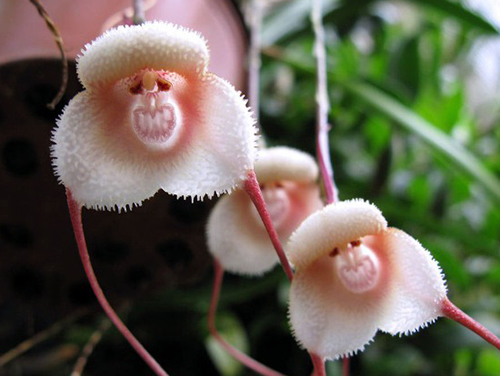
Rest period. The Dracula orchid does not need a dormant period, neither to stimulate flowering, nor in winter. It can bloom at any time of the year.
Reproduction. At home, the monkey orchid reproduces vegetatively by dividing a large adult bush into parts, while it is recommended to leave at least 4-5 shoots for each new plant.
Description
Attention: Dracula Orchid is a plant belonging to the genus Epiphytic of the Orchid family. Today, there are about 120 species, many of which are included in the lists of rare and endangered plants .. In the wild, it occurs in humid climates in South and Central America, growing on tree trunks or spreading along the surface of the soil
Epiphytes - plants that attach to other plants, but not parasitizing them, but using them as a support
In the wild, it occurs in humid climates in South and Central America, growing on tree trunks or spreading along the surface of the soil. Epiphytes are plants that attach themselves to other plants, but do not parasitize them, but use them as a support.
Representatives of this genus have short stems, long arrow-shaped leaves (green or dark green) and a shortened rhizome (rhizome). There are no pseudobulbs, their functions are partially performed by leaves that take on a spongy structure, which partially take on the functions of absent aerial tubers.
Of greatest interest is an unusual flower, which is very different from different species in shape, size and color. A common feature for all species is the presence of three sepals, collected at the base and forming a semblance of a bowl or hood.
The tips of the petals are extended outward and hair can often be observed on the outgrowths. In the core of the petals is the so-called lip (medial leaflet of the inner circle of the perianth).
Peduncles in monkey orchids are rarely directed downward, in most species they are single-flowered, straight or slightly drooping. The seeds are numerous and small, resembling a spindle.
A number of species (for example, Dracula simia) can bloom all year round.In natural conditions, flowers are pollinated not only by insects, but also by certain species of small rodents and bats.
Growing a Dracula orchid
These plants are amenable to cultivation, but they will not grow in climates that are very different from those of natural habitats. Unsuitable conditions lead to burn spots, dry leaf tips and premature flower fall. The greenhouse must be fairly cold and must be equipped with large fans and air conditioners; the maximum daytime temperature should not exceed 25 ° C.
Lighting: shade, partial shade.
Plants are best grown in wooden baskets or plastic aquatic plant pots. The containers can be lined with a layer of sphagnum and filled with Mexifern fiber and covered with plenty of live sphagnum on top.
To keep the moss in good condition, it is important to only use rainwater for irrigation. Young plants can be planted on Mexifern blocks with a small moss backing
Many collectors use dried New Zealand sphagnum.
The average temperature of most species is around 15 ° C. During warmer seasons, temperatures should not rise above 25 ° C.
Relative air humidity - 70-90%.
Dracula "Bat" (Dracula vespertilio). Orchi Benedict's Dracula (Dracula benedictii). Orchi Dracula chimaera. Orchi
Is it possible to grow the Dracula orchid at home

Perhaps the most original and incredible of the orchid species is Dracula. Its second name is monkey orchid because of the incredible similarity of its flowers to the face of a monkey. And she got the name Dracula due to the similarity of the flower, except with a monkey's face, and also with the mouth of a small dragon. Having seen a photo of these flowers for the first time, most people are inclined to think that the photos were taken using Photoshop, since they consider such a similarity of a flower to a living being to be incredible.
A bit of history and a brief description of the Dracula orchid
Dracula belongs to the type of epiphytic plants that grow mainly on trees, or rather on the lower parts of their trunks, and sometimes on the ground. The homeland of this species of orchid is the humid forests of Central and South America. The flower grows most often in mountainous areas at an altitude of 1-2 thousand meters above sea level. It was first discovered in 1870 by an amateur and collector of orchid plants, Benedict Roeznel.
Caring for the Makodes petola orchid at home
Lighting and location selection
Under natural conditions, this plant prefers to grow in darkened places with high humidity. When growing it in indoor conditions, conditions similar to natural conditions should be provided. So, makodes petola requires not very bright lighting, high air humidity, which should be at the level of 80-90 percent, heat and substrate, which is always in a humid state. For its cultivation, it is recommended to use a special greenhouse or florarium.
How to water
Water should not stagnate either in the substrate or in the pan, as this can lead to the formation of rot on the root system, as well as on the lower part of the shoot. It is necessary to water systematically. Watering is carried out as the soil dries up. Filtered or soft water is suitable for this.
Temperature regime
In summer, the plant grows well and develops at temperatures from 18 to 30 degrees, in winter - you need to make sure that it is not less than 18 degrees. A daily temperature difference is recommended, while the difference between day and night temperatures should be about 4 degrees. In the warm season, it is recommended to transfer this orchid to the street (to the balcony, to the garden). In this case, the plant must be protected from direct sunlight, precipitation and gusts of wind.
Earth mixture
To prepare the soil mixture with your own hands, you need to combine the fine-grained bark of coniferous trees, rotted leafy soil, coarse sand, foam plastic, sphagnum, charcoal, expanded clay, as well as broken shards. Do not forget to make a not very thick drainage layer at the bottom of the container. After planting the plant, a not very thick layer of moss should be laid on top of the soil mixture. Experts advise to transplant in March – April. Such an orchid needs a cramped pot, the diameter of which does not exceed 6 centimeters.
Fertilizer
Top dressing is carried out carefully, as the delicate roots can burn out. From spring to autumn, they are fed once every 3 weeks, and after that - once every 5 weeks.
To prepare a nutrient solution, 3 or 4 drops of fertilizer are poured into 2 liters of water. A high concentration of the solution has a detrimental effect on the root system. It is recommended to use a specialized fertilizer for orchids for feeding, since fertilizers for other indoor plants contain completely different nutrients.
Breeding method
When grown indoors, this plant can be propagated by cuttings or by dividing an overgrown specimen. When dividing, you need to make sure that there are at least 3 sprouts on each division. This plant has a branched, creeping stem. In the event that roots appear next to the adult leaves, it will be possible to carry out the grafting procedure. A part of the shoot is cut onto the cutting, while it must necessarily have 2 or 3 stem nodes and roots. Places of cuts should be treated with crushed charcoal or activated carbon. Then the cutting is dried and planted in the prepared soil mixture. Also, for rooting, a glass of water is sometimes used, into which chopped charcoal should be added. Leafless stem cuttings are also used for reproduction. They should be placed horizontally on moistened sphagnum, and the cutting should not be buried.
Diseases and pests
One of the common causes of flower disease is non-compliance with the conditions of proper care, for example, drafts, direct sunlight, frequent changes in the location of the flower.
Basically, the Dracula orchid attracts the following types of pests.
Thrips. Their presence on the plant is determined by the gray color of the leaves and the presence of small dots on them. It is not easy to destroy thrips, the flower is treated with special means - acaricides. For prevention, some growers use garlic tincture spraying.
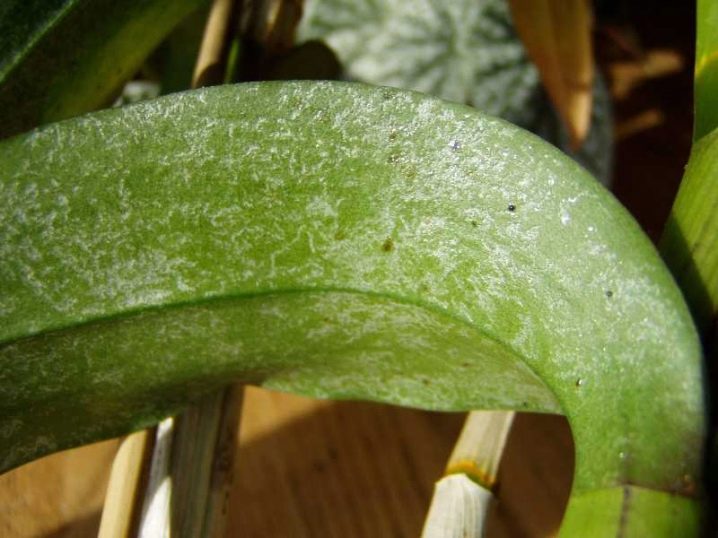



The appearance of bright brown spots on the foliage, rot, drying of the flower are signs of fungal infection. For treatment, the orchid is isolated from other plants to exclude the possibility of infection, then the flower is treated with a fungicide.
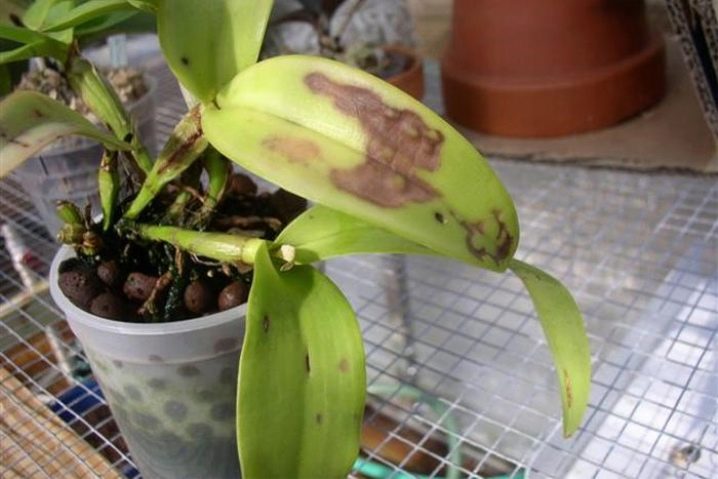
The presence of bacterial rot is indicated by brown watery spots that spread quickly when the temperature drops. At the initial stage of infection, small spots are treated with charcoal or copper-containing preparations. If the disease progresses, in order to avoid its further spread to other flowers, Dracula must be destroyed.
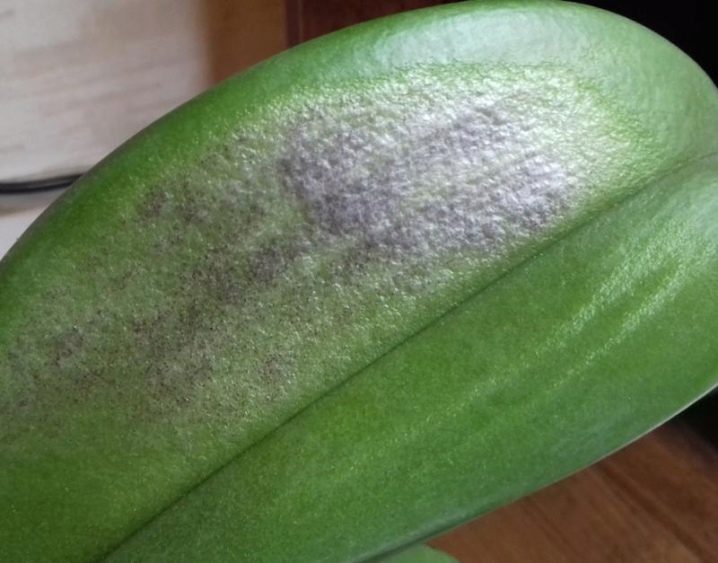
In order to grow Dracula at home on your own, the following conditions must be met:
- adequate lighting;
- nutrient substrate;
- temperature regime;
- sufficient watering and moisture level;
- timely feeding and pest control.
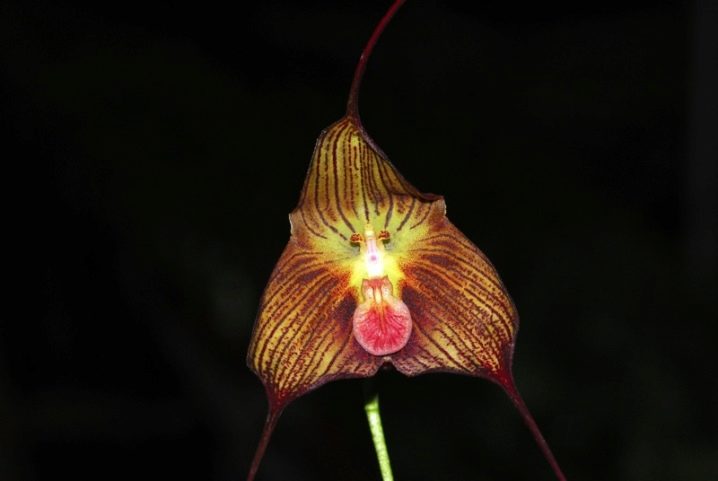
The transplanting process is carried out in the spring, when the orchid already has leaves, but does not bloom yet. In case of depletion and acidification of the nutrient mixture, excessive growth of roots or their decay, the transplant should be carried out as soon as possible.
